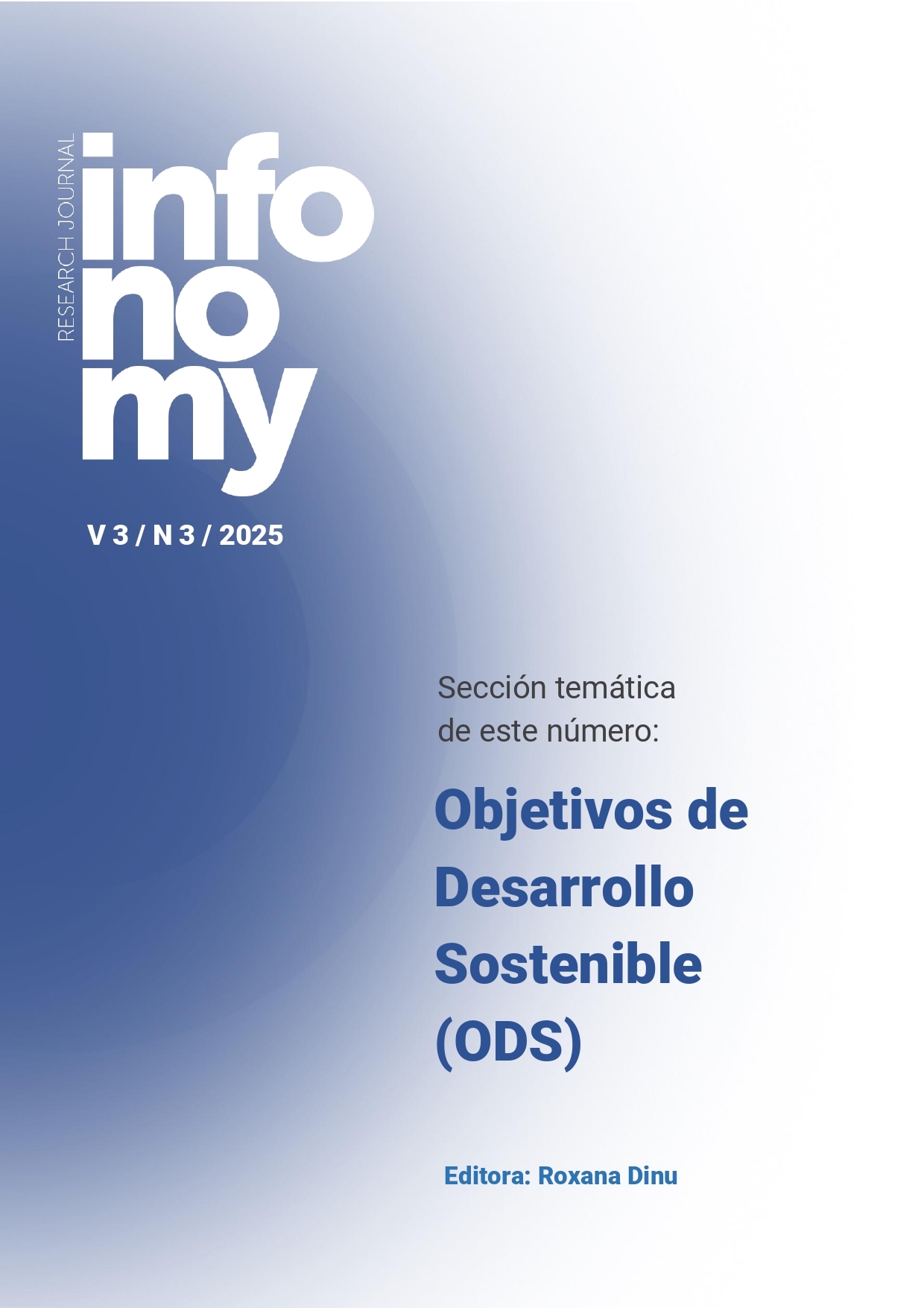Measuring Interdisciplinarity: A Graph-Based Analysis of Brazilian Academic Committees
DOI:
https://doi.org/10.3145/infonomy.25.018Palabras clave:
Academic Committees, CAPES, Graph Theory, Interdisciplinarity, Knowledge Areas, Motifs, Scientometrics, Social Networks, Scientific collaboration, Doctoral dissertations, Theses, Knowledge Discovery, Patterns, BrazilResumen
This study presents a scientometric analysis of interdisciplinary scientific collaboration in the composition of academic committees in Brazil. The research employed an extensive dataset, obtained from CAPES and Sucupira platforms, which store information on Brazilian academic output: master's and doctoral dissertations and theses. The collected data enabled the examination of relationships between 66 Knowledge Areas (KAs). Applying graphs to model the relationships among committee members, we distinguished each member according to their assigned role: candidate, evaluator, advisor. Three "academic graphs" were designed to represent these relationships: evaluations, invitations, and co-participations. As a method, we adapted a Knowledge Discovery in Database (KDD) process, systematizing the necessary steps to enable the desired measurement. Applying statistical techniques, the research results revealed significant patterns of interdisciplinarity in the composition of the committees. It was possible to identify KAs that collaborate more frequently (Ecology, Education, Linguistics, Zoology), as well as those that demonstrate less interaction, in addition to the relative role of each as a hub for other areas (Biochemistry, Education, Chemistry, and Sociology). This study contributes to a deeper understanding of the role of defense committees in the advancement of Brazilian science, emphasizing the relevance of interdisciplinary collaboration in the evaluation of academic output.Citas
Arroyo-Machado, W. (2024). Exploring Wikidata for Social Science research. Infonomy, 2(2)e24034. https://doi.org/10.3145/infonomy.24.034
Benzi, K.; Ricaud, B.; Vandergheynst, P. (2016). Principal patterns on graphs: Dis-covering coherent structures in datasets. IEEE Transactions on Signal and Infor-mation Processing over Networks, 2(2)160-173. https://ieeexplore.ieee.org/document/7398168
Fayyad, U. (2001). Knowledge discovery in databases: An overview. In Relational Data Mining. Springer Berlin Heidelberg, 28-47. https://doi.org/10.1007/978-3-662-04599-2_2
Fayyad, U.; Piatetsky-Shapiro, G.; Smyth, P. (1996). From data mining to knowledge discovery in databases. AI Magazine, 17(3). https://doi.org/10.1609/aimag.v17i3.1230
Huutoniemi, K.; Thompson Klein, J.; Bruun, H.; Hukkinen, J. (2010). Analyzing inter-disciplinarity: Typology and indicators. Research Policy, 39(1)79-88. https://doi.org/10.1016/j.respol.2009.09.011
Karlqvist, A. (1999). Going beyond disciplines: The meanings of interdisciplinari-ty. Policy Sciences, 32(4)379-383. https://doi.org/10.1023/A:1004736204322
Koutra, D.; Faloutsos, C. (2017). Individual and Collective Graph Mining: Prin-ciples, Algorithms, and Applications. Morgan & Claypool. https://doi.org/10.1007/978-3-031-01911-1
Milo, R.; Shen-Orr, S.; Itzkovitz, S.; Kashtan, N.; Chklovskii, D.; Alon, U. (2002). Net-work motifs: Simple building blocks of complex networks. Science, 298(5594)824-827. https://www.science.org/doi/10.1126/science.298.5594.824
Morillo, F.; Bordons, M.; Gómez, I. (2001). An approach to interdisciplinarity through bibliometric indicators. Scientometrics, 51(1)203-222. https://doi.org/10.1023/A:1010529114941
Newman, M. E. J. (2001). Scientific collaboration networks. I. Network con-struction and fundamental results. Physical Review E, 64(1). https://doi.org/10.1103/PhysRevE.64.016131
Porter, A. L.; Cohen, A. S.; David Roessner, J.; Perreault, M. (2007). Measuring re-searcher interdisciplinarity. Scientometrics, 72(1)117-147. https://doi.org/10.1007/s11192-007-1700-5
Ribeiro, P.; Paredes, P.; Silva, M. E. P.; Aparicio, D.; Silva, F. (2021). A survey on subgraph counting: Concepts, algorithms, and applications to network motifs and graphlets. ACM Computing Surveys, 54(2). https://doi.org/10.1145/3433652
Ribeiro, P.; Silva, F. (2010). G-tries: An efficient data structure for discovering network motifs. In: Proceedings of the 2010 ACM Symposium on Applied Computing. Sierre, Switzerland: Association for Computing Machinery, 1559-1566. https://doi.org/10.1145/1774088.1774422
Roberts, C. M. (2010). The Dissertation Journey: A Practical and Comprehensive Guide to Planning, Writing, and Defending your Dissertation. Corwin Press, 2nd edi-tion. https://www.corwin.com/books/dissertation-journey-4e-283256
Romijn, L.; Nualláin, B. Ó.; Torenvliet, L. (2015). Discovering motifs in real-world so-cial networks. In: SOFSEM 2015: Theory and Practice of Computer Science. Pec pod Sneûkou, Czech Republic: Springer Berlin Heidelberg, (8939)463-474. https://doi.org/10.1007/978-3-662-46078-8_38
Schwöbbermeyer, H. (2008). Network motifs. In: Analysis of Biological Networks. Gatersleben, Germany: John Wiley & Sons, 85-111. https://www.wiley.com/en-br/Analysis+of+Biological+Networks-p-9780470041444
Sinha, S.; Bhattacharya, S.; Roy, S. (2022). Impact of second-order network motif on online social networks. The Journal of Supercomputing, 78(4)5450-5478. https://doi.org/10.1007/s11227-021-04079-7
Wang, Q.; Zou, B.; Jin, J.; Wang, Y. (2024). Studying the linkage patterns and incre-mental evolution of domain knowledge structure: a perspective of structure decon-struction. Scientometrics, 129(2024)4249-4274. https://doi.org/10.1007/s11192-024-05059-3
Yu, Q.; Tao, R.; Jiang, S. (2023). Exploring the evolution of interdisciplinary citation network by the colored network motifs: the case of perovskite materials. Scientomet-rics, 128(8)4421-4446. https://doi.org/10.1007/s11192-023-04777-4
Descargas
Publicado
Cómo citar
Descargas
Dimensions
Número
Sección
Licencia
Derechos de autor 2025 Victor A. P. Mansueli, Jesús P. Mena-Chalco

Esta obra está bajo una licencia internacional Creative Commons Atribución 4.0.




